Calming Dogs with Storm Phobias
Posted: 07/23/2022 | BY: Erin Cain | Categories: Behavior , Dog , Pet care
If your dog is afraid of thunder, a stormy day is the worst thing to happen. Your dog may pace, whine, pant, or become destructive during the storm. You worry about the emotional damage and physical harm your dog could suffer during this stressful event. Storm phobias affect many dogs, but there are ways to help them cope. Here are some helpful tips to keep your dog calm during thunderstorms.
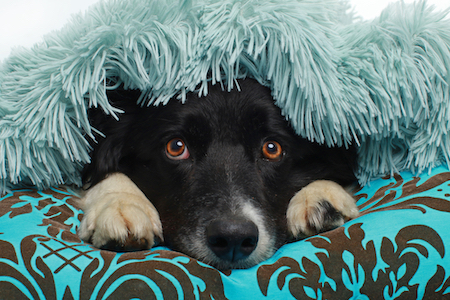
Why are so many dogs afraid of thunderstorms?
Thunderstorms may be a source of anxiety for some dogs because they can hear them before people can. After all, canines are susceptible to sound, and their ability to hear is far beyond human capability. Additionally, it’s instinctual for dogs to be afraid of loud noise and to want to hide from it. Thunder is a big part of that reaction.
Even veterinarians are unsure of the anxiety triggers at work when it comes to canine storm phobias. Still, many vets suspect that fearful dogs are set off by thunder, lightning, barometric pressure changes, static electricity, wind, and low-frequency rumbles preceding a storm. According to one theory, some dogs may experience painful shocks from static buildup before the storm.
Canines may also associate the sound of thunder with other loud and frightening noises like fireworks or gunshots or memories of previous trauma they’ve experienced. Regardless of the cause, if your pup fears thunder, you want to do everything possible to calm her down and keep her safe from harm.

What are the signs of thunderstorm anxiety in dogs?
There is a wide range in how some dogs react to thunderstorms. Some pups experience mild anxiety, while other dogs injure themselves to escape the source of their fear. Here are some signs to watch for if your dog has a storm phobia:
- pacing
- hiding
- excessive panting
- trembling
- whining or other vocalizations
- chewing
- digging
- excessive yawning
- ears pinned back
- wide eyes
- drooling
- urination or defecation
- changes in personality or behavior
In the worst cases, some dogs will run away or jump through windows to escape and find a place to hide. Unfortunately, in their panic, dogs may injure themselves in attempting to escape the storm.
Don’t despair if your dog suffers from storm phobias! Here are some tips to keep your pup calm when thunderstorms roll in.
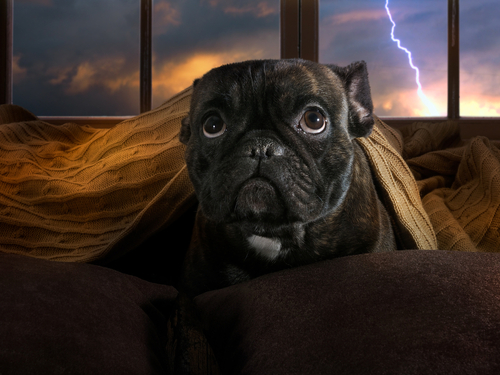
Tips to keep your pup calm while it storms on.
Be home with your dog.
If a thunderstorm is forecast in your area, try to be home with your dog before it begins. For some fearful dogs, being alone during a thunderstorm only worsens their anxiety, potentially promoting more destructive and nervous behaviors. If you cannot be home with your dog during the storm, have a family member or friend fill in for you until you can get there.
Remain calm and don’t make a big deal about the storm.
Have a relaxed attitude, and as difficult as it may be, don’t reassure your dog when she shows signs of fear. Comforting your dog when she is scared won’t help; in fact, it reinforces her behavior as she will think that if you are concerned, then the storm is a threat. Remember, your dog can easily pick up on your emotional state, so if you’re stressed and anxious about the storm, your dog will, too.
Instead, speak to your dog positively yet quietly to reassure her and increase her confidence. Don’t ever punish your pup for her fearfulness, no matter how many parts of the carpet she digs at and destroys.
Provide a safe space for your dog.
Create a safe indoor space for your pup to hide during storms. It can be the dog’s crate, a closet, a bathroom, a basement, or any dark and quiet area where she feels comfortable and secure.
Instinctually, dogs like den-like environments that harken back to the safe places their ancestors sought in the wild. The smaller space makes dogs feel safer because the spot is familiar. Before the storm starts, get into a routine and encourage your dog to take shelter in her “safe place.” Additionally, ensure that your pup has access to her safe space should a storm occur when you aren’t at home.
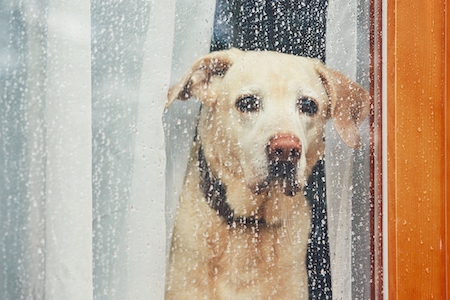
Create some competition.
Compete with the noise of the storm by drowning out the thunder. Use a white noise machine, play the radio, or encourage your dog to relax to a specially designed dog-calming music playlist by streaming music services like Spotify or Amazon Music Unlimited. Also, there are many dog-calming music videos on YouTube to play that may distract and ease fearful and anxious dogs.
Use calming remedies.
There are many natural ways to help your dog deal with storm anxiety. Try using an anti-anxiety vest, shirt, or jacket, which replicates swaddling and may soothe them into a state of calmness. Bach flower extract found in supplements like Rescue Remedy can also work well for mild-to-moderate cases of storm-related anxiety. For some dogs, lavender oil diffusers or pheromone collars promote calmness and relaxation during these weather events.
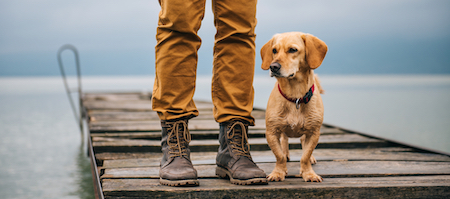
Try desensitization techniques.
Incorporate desensitization techniques to turn your dog’s anxiety into a positive moment. Play a recording of a thunderstorm at a low volume while simultaneously giving your dog high-reward treats and praise. In other words, they don’t get quality treats for anything else they do. You want to teach your dog to associate the sound of thunder with special treats they don’t get otherwise. This action builds a positive connection in your pup over time.
Over the next few weeks, slowly increase the volume of the recorded storm until your dog remains calm and relaxed whenever she hears the recording. With practice, your dog may someday react to storms simply by looking for a tasty treat and a kind word from you.
Talk to your vet about anti-anxiety medications.
The highly anxious dog is often difficult to work with, and desensitization training or other distraction methods may not do the trick. In these cases, a visit to your veterinarian may be needed to discuss medication and find other options that won’t stress their physical and mental health.
For dogs with moderate to severe episodes of storm phobias, a short-term anti-anxiety medication can be prescribed to help the dog cope with the event. Your pup must be healthy before starting any new medicines, especially ones designed to reduce anxiety.
Dogs who suffer from immense stress and anxiety due to thunder typically have other stress-inducing phobias, such as separation anxiety. These dogs are often good candidates for long-term anti-anxiety medications because otherwise, their fear and its impact on their mental and physical states are crippling and affect the dogs’ quality of life.
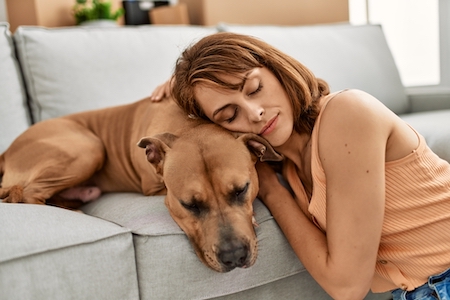
Weather the storm with a dog health insurance policy.
If you’re worried that your pet may have storm anxiety, schedule an appointment with their veterinarian. They can discuss the severity of your pup’s anxiety and determine whether medications, behavioral modifications, natural remedies, or a combination of all three will help keep her calm during a storm.
Remember, the cost of vet visits and medications adds up quickly. Get reimbursed for most of those costs with a pet insurance plan for your dog. Pet Insurance Review finds the best insurance deals from top providers, so you and your dog can rest easy no matter the storm. Get your pup’s free quote today!
References:
- Veterinary Specialists of the Rockies. (2022). Why Are Dogs Afraid of Thunderstorms? Retrieved from https://vetsoftherockies.com/education/why-are-dogs-afraid-of-thunderstorms/
- Curtis, T. (2013). Noise and Storm Phobias and Anxiety in Dogs. Retrieved from https://todaysveterinarypractice.com/behavior/noise-storm-phobias-anxiety-in-dogs/
- Madsen, C. (2022). How to Set Up a Safe Space for Your Dog. Retrieved from https://www.preventivevet.com/dogs/how-to-set-up-a-safe-space-for-your-dog
- American Humane. (2016). Dog Dens. Retrieved from https://www.americanhumane.org/fact-sheet/dog-dens/
- Pet Care Music Therapy. (2016). Soothing Music for Dogs – Calming and Relaxing Music for Putting a Dog to Sleep, Pet Therapy. Retrieved from https://open.spotify.com/album/7bmy5EqkGvp4ThC2lHgVOO
- Llera, R., Buzhardt, L. (2022). Anxiety Vests for Dogs. Retrieved from https://vcahospitals.com/know-your-pet/anxiety-vests-for-dogs
- Henriques, J. (2021). Why I Changed My Mind About Bach Flower Remedies. Retrieved from https://www.dogsnaturallymagazine.com/changed-mind-bach-flower-remedies/
- Jones, E. (2021). Dog Desensitization: How to Get Your Dog Used to Anything. Retrieved from https://www.k9ofmine.com/dog-desensitization/
- Fatcheric, E. (2022). Anxiety Medication for Dogs. Retrieved from https://www.whole-dog-journal.com/health/anxiety-medication-for-dogs/
Disclaimer
The information contained on this blog is intended for informational and educational purposes only and should not be construed as medical advice. It is not a substitute for professional veterinary care. Always consult with your veterinarian before making any changes to your pet's health care or treatment plan.
The authors of this blog are not veterinarians and do not claim to be experts in pet health. The information provided here is based on our own experiences and research, as well as information from reputable sources. However, we cannot guarantee the accuracy or completeness of this information.
We encourage you to do your own research and consult with your veterinarian before making any decisions about your pet's health.
Previous post
Signs of Pancreatitis in DogsNext post
Is Grain-Free Dog Food Harmful to Dogs?Compare top pet insurance providers plans.
Enter your dog’s age in years and months to calculate their age equivalent to human years.
Calculate your dog’s ageEnter your cat’s age in years and months to calculate their age equivalent to human years.
Calculate your cat’s age